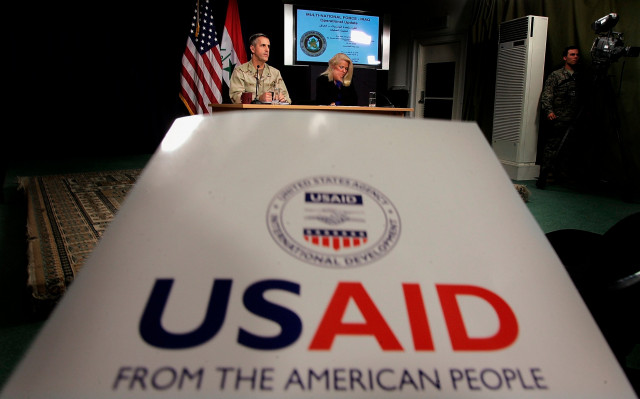Real cost of working with aid money
Donor-funded programmes in agri-sector leave govt oversight to minimum

PHOTO: REUTERS
However, in addition to this inadequate policy support another factor that needs to be highlighted is the influence of major sector support programmes usually led by foreign contractors and funded by different aid agencies over the last fifteen to twenty years.
Agriculture, dairy and horticulture have been the favourite picks of several donors, especially USAID. For example, in 2006 the Pakistan Initiative for Strategic Development & Competiveness (PISDAC) project supported the dairy and horticulture sector. Later in 2009-10 ‘Firms’ project worked on key agriculture value chains and there are several other projects; such as the Agribusiness project, agriculture innovation project and provincial programmes.
All these programmes come with big promises and large amounts of funds to support competiveness, productivity, yields, exports, varieties, quality and every possible characteristic one can think off. Surprisingly, all these programmes have project completion reports suggesting that the interventions have been extremely successful and added positive value.
Muddled World Bank report: Pakistan ‘needs’ $31b this year to stay afloat
Dilemma of delivery through aid programmes
Reading these reports, one gets an impression that a lot of issues and problems faced by the agriculture sector have been addressed. While there is certain truth to these claims, the question remains on what rubric have they been measured. For example, the PISDAC project began engaging farmers, growers, processors, exporters, academia, and other local stakeholders including the public sector in summer of 2006.
The focus area was horticulture with two specific streams of interventions. The programme aimed at improving apple and grape production in Balochistan, and planned to focus on the mango production in Multan and Sindh. PISDAC also made strong collaborations with agencies such as Pakistan Horticulture Development & Export Board (PHDEB).
The programme established large strategy groups and each of them inherently focused on key value chain issues of the sector. Many consultations were held regularly in Islamabad and Quetta (apple/grape) and Lahore and Multan (Mango) to analyse industry issues through diagnostics such as value chain analysis, benchmarking against competitors, market analysis, identifying strengths and weaknesses and developing a strategy – that can then be implemented in partnership with the government.
The project reports available openly state that these dense consultations identified some major hindrances impacting competiveness of Pakistani horticulture sector. For example, the key challenges identified in increasing the competitiveness of mango producers were the almost nonexistence of post-harvest infrastructure and a poorly developed marketing system that resulted in poor quality mangoes and losses ranging from 30-40% from harvest to market.
Additionally, the value chain analysis conducted by the project revealed that Pakistani mangoes in foreign markets have a reputation of poor quality, with exporters having a tendency of dumping the fruit in markets such as the UAE in some cases, or selling in ethnic markets in the UK as opposed to more sophisticated outlets such as supermarkets where the fruit can be sold at higher prices.
The project also sponsored a generous benchmarking tour to the Fruit Logistica fair in Berlin in February of 2007. This was considered an essential element to increase awareness among ‘members’ of the importance of Global GAP certification. It was said that this provided significant networking opportunities to get in touch with modern retailers and importers from across the globe – in short, the Pakistani mango will soon be on a large number of shelves across the world.
Pakistan may soon be ineligible for World Bank loans
Resulting from these benchmarking and diagnostic activities was an apparent strategy which talked about market linkages, work force development, policy issues, value chain and marketing improvements.
The programme was declared a big success as it achieved all its stipulated targets. One would expect that given that all of this happened between 2006-08, Pakistani mangoes must have taken over major market shares in high value markets such as Europe and the US.
Ironically, today in 2017, our diagnostics are stating the same very things that were debated in 2006. Pakistan has the world’s best mango; however, due to quality issues, post-harvest losses, poor packaging, lack of marketing and poorly articulated value chains we are unable to export.
A simple comparison tells us that we have been static for ten years – how does one survive in a world which is driven by efficiency of micro-seconds?
Opportunity cost of broken promises
Although mango has been discussed as an example, the cases of other fruits, vegetables and agricultural products are not any different. Large sums of grant money and loans have been spent in the name of supporting these sectors, with project reports claiming to have ‘changed lives’ but in most cases this change is difficult to find on ground.
An argument usually made is that it is the donors’ own resources which are being granted as aid and hence their misuse or low effectiveness has no implication on finances of the government or the country and thus it does not matter.
We beg to differ; there may be no outlay of resources directly, but when the government begins to work with these large programmes, they feel their work is done, and they leave the sector in the hands of their development partners.
The government shies away from supporting these sectors because it feels that the development partners have promised to deliver magnanimous results. Whereas, these programmes may result in small micro level successes, they badly fail to reform the entire sector.
The cost to the country really comes from the government becoming static under the impression that all is being taken care of by the funded programmes. Thus, what we lose as a nation is not dollars but something that’s more precious – time!
Governance model in Punjab
Punjab’s historic experience with such programmes has not been any different. However under the current leadership of planning and development department, the provincial decision-makers have become more conscious about their roles and responsibilities in managing results promised by development partners.
The planning and development department now plays an aggressive role in defining the donor landscape in the Punjab. The External Capital Assistance wing is also being strengthened to build critical development negotiation capacity.
Moreover, the province is taking a more strategic approach in developing ‘home grown’ solutions to actual problems and aims to drive the agenda of the development partners rather be driven by it.
In our next article we will try to present some of the major reforms that have occurred over the last two years that are and will in future ensure that aid-driven projects are relevant and address real issues that result in better lives for our citizens.
Muhammad Usman Khan is an Adviser and Dr M Aman Ullah is Chief Economist at the Planning and Development Department, Government of Punjab
Published in The Express Tribune, November 13th, 2017.
Like Business on Facebook, follow @TribuneBiz on Twitter to stay informed and join in the conversation.





1735506669-0/image-(16)1735506669-0-208x130.webp)













COMMENTS
Comments are moderated and generally will be posted if they are on-topic and not abusive.
For more information, please see our Comments FAQ